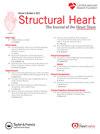经导管主动脉瓣置换术后心包填塞的结果:来自三级心脏中心的结果
IF 1.4
Q3 CARDIAC & CARDIOVASCULAR SYSTEMS
引用次数: 0
摘要
背景:心包填塞是经导管主动脉瓣置换术(TAVR)中一种罕见但潜在致命的并发症。目前缺乏评估TAVR术后心脏填塞发生率和预后的证据。方法回顾性分析2013年1月至2019年1月在我院接受TAVR治疗的所有患者。比较围手术期发生心包填塞的患者与未发生心包填塞的患者的临床特点。分析了心脏计算机断层扫描对主动脉环钙分布的定性和定量评价。结果30例患者中有20例(0.9%)在tavr术后出现心包填塞。发生心包填塞的队列平均年龄为81.7岁,其中50%为男性。其中大多数发生在术中(70%),其余发生在术后。造成心包填塞的损伤部位被认为是主动脉环(50%)、右心室(40%)和左心室(10%)的损伤。术中发现由环室或左心室外伤引起的填塞(91%;11例中有10例),而假定是右心室损伤导致的心包填塞多数是在手术后发现的(62.5%;N = 5 / 8) (p = 0.009)。90%的心包填塞患者采用保守治疗和支持治疗,2例患者行心脏手术。有1例院内死亡,另1例患者在TAVR手术后30天内死亡。结论TAVR术后心包填塞发生率较低(0.9%),在大容量中心采用流线手术流程的大多数患者中,这种严重并发症均能得到成功控制。本文章由计算机程序翻译,如有差异,请以英文原文为准。
Outcomes of Cardiac Tamponade Post-Transcatheter Aortic Valve Replacement: Results From a Tertiary Cardiac Center
Background
Cardiac tamponade is a rare but potentially lethal complication of transcatheter aortic valve replacement (TAVR). There is paucity of evidence assessing the incidence and outcomes of patients with cardiac tamponade after TAVR.
Methods
A retrospective review was performed of all patients who underwent TAVR at our institution from January 2013 to January 2019. The clinical characteristics of patients who developed cardiac tamponade in the periprocedural period were compared to the patients who did not develop tamponade. Qualitative and quantitative assessment of aortic annular calcium distribution on cardiac computerized tomography was analyzed.
Results
Twenty out of 2030 patients (0.9%) developed cardiac tamponade post-TAVR. The mean age of the cohort developing cardiac tamponade was 81.7 years, and 50% of them were men. Most of these were intraprocedural (70%) while the remaining were identified in the postprocedural period. The site of injury resulting in pericardial tamponade was thought to be from the injury to aortic annulus (50%), right ventricle (40%), and left ventricle (10%). Tamponade due to annular or left ventricular trauma was mostly identified intraprocedurally (91%; n = 10 of 11), while patients with tamponade due to presumed right ventricular injury were mostly identified in the postprocedural period (62.5%; n = 5 of 8) (p = 0.009). Conservative management with supportive therapies was employed in 90% of patients with cardiac tamponade, while two patients had cardiac surgery. There was one in-hospital mortality, and another patient died within 30 days of the TAVR procedure.
Conclusion
The incidence of cardiac tamponade after TAVR (0.9%) was low, and this serious complication can be managed successfully in the majority of patients with streamlined processes in high-volume centers.
求助全文
通过发布文献求助,成功后即可免费获取论文全文。
去求助
来源期刊

Structural Heart
Medicine-Cardiology and Cardiovascular Medicine
CiteScore
1.60
自引率
0.00%
发文量
81
 求助内容:
求助内容: 应助结果提醒方式:
应助结果提醒方式:


